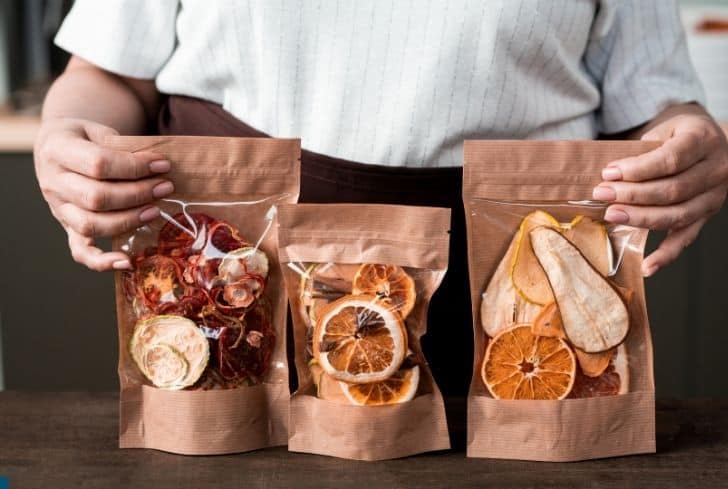Before we dive into why and how biodegradable packaging is beneficial, we need to understand what it is. Biodegradable packaging refers to packaging material that’s made up of biopolymers. Biopolymers are organic compounds found in living organisms like cellulose and proteins.
That means that they can be safely consumed and readily decomposed by microorganisms such as bacteria, fungi, and algae, with minimal impact on the environment.
Biodegradable packaging is an excellent alternative to plastic which brings numerous consequences to the environment. Plastic has a slower decomposing rate, and this affects the natural ecosystem. Biodegradable packages may be made from the following materials:
- Cornstarch
- Seaweed
- Mushrooms
How is Biodegradable Packaging Different From Compostable Packaging?
Compostable packaging is similar to biodegradable packaging in that it also decomposes in a manner that is kind to the environment. The added advantage that compostable packaging has over biodegradable packaging is the guarantee that it won’t produce any toxins upon decomposition.
Once compostable packaging is fully broken down, it turns into ‘compost,’ providing the soil with nutrients needed for plant growth.
Again, while biodegradable packaging doesn’t have a set timeframe upon which it’ll break down, compostable packaging comes with a guarantee that it’ll break down within a specified timeframe or at reaching a particular temperature.
Why We Should Use Biodegradable Packaging Material?
Making the shift to biodegradable packaging materials is becoming incredibly important for businesses. This is because consumers are more inclined to shop with brands concerned with recycling and are making better environmentally friendly decisions. By adopting biodegradable packaging, you bring the following benefits to yourself and the environment:
1. Reduction of the carbon footprint
Reduce the amount of carbon your business uses by leveraging biodegradable packaging. These are usually made using recycled materials as opposed to plastics that use harsh chemicals. This makes biodegradable packaging a much safer alternative for the environment.
The manufacturing process significantly reduces wastage by lowering the number of resources consumed. These efforts go a long way in reducing the carbon footprint, helping businesses meet the high standards of environmental compliance.
2. No harmful plastics
Plastic packaging materials are often petroleum-based and have, so far, contributed majorly to environmental issues. You will find these products littering landfills, beaches, waterways, roadsides, and parks. The manufacture of such traditional packaging and shipping materials also requires a high amount of energy and resources, making these solutions non-sustainable.
Using biodegradable packaging will help reduce the amount of plastic used and thrown out. Ultimately, you’ll have helped minimize littering issues related to using plastics.
3. Ease of disposal
Businesses need to ensure that the type of packaging used for their products is easy to dispose of. Biodegradable packaging simplifies disposal; hence it’s convenient for consumers. Two of the best options are recyclable packaging and biodegradable packaging.
Usually, biodegradable packaging decomposes on its own after use without requiring further resources. Consumers would rather go for this than other materials that have a long disposal process. People do not mind paying for this convenience.
4. Versatility
This is yet another key benefit of using biodegradable packaging. The solutions are very versatile and can typically be repurposed for whichever industry. It doesn’t matter if you need biodegradable packaging to package meal kits, electronic devices, or anything in between – there is a biodegradable packaging option available to suit your business needs.
5. Sustainability
This last point is quite obvious, considering that this is the whole purpose of biodegradable packaging. Most biodegradable packaging materials are reduceable, reusable, and recyclable.
Tips For Using Biodegradable Packaging
To ensure that you’re getting the most out of your biodegradable packaging materials, you need to ensure that you’re using them correctly. Here are the tips for using biodegradable packaging materials:
- Think hard about whether you need packaging. If your products don’t need packaging, there’s no need to waste resources.
- As part of doing your bit for the environment, ask your customers to bring packaging they got earlier from shopping with you. This will encourage them to keep it safe for later use.
- Be truthful and keep your word. If you sell your brand as one that doesn’t produce plastic waste, you should be sure to do just that. Shoppers will feel cheated if they find out that you lied.
Use Suitable Packaging Material For Your Business.
What we’ve talked about concerning the benefits of using biodegradable packaging materials is just the tip of the iceberg. These do an even better job than plastics, and it’s no question that they’re the best option for a business’s packaging needs.
As a business owner, it’s your responsibility to help conserve resources by reducing the number of new materials needed to make new packaging products. Protect the environment by reducing pollution levels in the air, groundwater, and soil.






